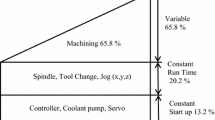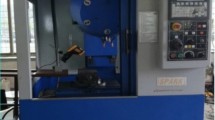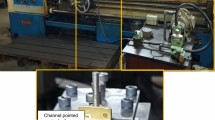Abstract
This paper focused on the effect of geometrical and machining parameters such as rake angle, nose radius, cutting speed, feed rate, and depth of cut on temperature rise during end milling operation. The experiments were conducted on Al 6351 with high-speed steel end mill cutter. Central composite rotatable experimental design methodology was employed to conduct the experiments. The temperature rise during machining was measured using K-type thermocouple coupled with the thermal indicator. A prediction model was developed using response surface methodology and the adequacy of the model was verified using analysis of variance. The predictive model was used to analyze direct and interaction effect of the machining parameters on temperature rise, which helps to select proper combination of machining parameters to obtain better quality in machining. Genetic algorithm was applied to optimize the machining process parameters to obtain minimum rise in temperature. A program was developed using C language to do the optimization and the best optimal combination of machining parameters gave a value of 0.0105 °C.







Similar content being viewed by others
References
Leshock CE, Shin YC (1997) Investigation of cutting temperature in turning by a tool-work thermocouple technique. ASME J Manuf Sci Eng 119:502–508
Smart EF, Trent EM (1975) Temperature distributions in tools used for cutting iron, titanium and nickel. Int J Prod Res 13:265–290
Shaw MC (1984) Metal cutting principles. Oxford University Press, London
Pittala GM, Monno M (2011) A new approach to the prediction of temperature of the work piece of face milling operations of Ti-6Al-4 V. Appl Therm Eng 31:173–180
Satoa Masahiko, Uedab Takashi, Tanakaa Hisataka (2007) An experimental technique for the measurement of temperature on CBN tool face in end milling. Int J Mach Tools Manuf 47:2071–2076
Kadirgama K, Noor MM, Rahman MM, Harun WSW, Haron CHC (2009) Finite Element Analysis and Statistical Method to Determine Temperature Distribution on Cutting Tool in End-Milling. Eur J Sci Res 30:451–463
Suhail AH, Ismail N, Wong SV, Abdul Jalil NA (2010) Optimization of Cutting Parameters Based on Surface Roughness and Assistance of Workpiece Surface Temperature in Turning Process. Am J Eng Appl Sci 3:102–108
Liu YJ, Zhang JM, Wang SQ (2005) Parameter estimation of cutting tool temperature nonlinear model using PSO algorithm. J Zhejiang Univ (Sci) 6A:1026–1029
Liu YM, Wang CJ (1999) A modified GA based optimisation of milling parameters. Int J Adv Manuf Technol 15:796–799
Palanisamy P, Rajendran I, Shanmugasundaram S, Saravanan R (2008) Prediction of cutting forcer and temperature rise in endmilling operation. Proc Inst Mech Eng B J Eng Manuf 220:1577–1587
Saglam Haci, Unsacar Faruk, Taldir Suleyman (2006) Investigation of the effect of rake angle and approaching angle on main cutting force and tool tip temperature. Int. J Mach Tool Manuf 4(2):132–141
Thangavel P, Selladurai V (2008) An experimental investigation on the effect of turning parameters on surface roughness. Int J Manufacturing Res 3:285–300
Sahoo P, Barman TK, Routara BC (2008) Fractal dimension modelling of surface profile and optimisation in CNC end milling using Response Surface Method. Int J Manuf Res 3:360–377
Ginta Turnad L, Nurul Amin AKD, Mohd Radzi HCD, Lajis Mohd Amri (2009) Tool Life Prediction by Response Surface Methodology in End Milling Titanium Alloy Ti-6Al-4V Using Uncoated WC-Co Inserts. Eur J Sci Res 28:533–541
Goldberg DE (1989) Genetic algorithms in search, optimization and machine learning. Addison-Wesley Pub, New York
Cochran WG, Cox GM (1963) Experimental design. Asia Publishing House, India
Montgomery DC (1976) Design and analysis of experiments. Wiley, New York
Sivasakthivel PS, Sudhakaran R (2013) Optimization of machining parameters on temperature rise in end milling of Al 6063 using response surface methodology and genetic algorithm. Int J Adv Manuf Technol. doi:10.1007/s00170-012-4652-8
Deb K (1995) Optimization for engineering design: algorithms and examples. Prentice-Hall, New Delhi
Priarone Paolo Claudio, Rizzuti Stefania, Settineri Luca, Vergnano Guido (2012) Effects of cutting angle, edge preparation, and nano-structured coating on milling performance of a gamma titanium aluminide. J Mater Process Technol 212:2619–2628
Stephenson DA, Agapiou JS (2006) Metal cutting theory and practice. Taylor & Francis, New York
Author information
Authors and Affiliations
Corresponding author
Additional information
Technical Editor: Alexandre Mendes Abrao.
Rights and permissions
About this article
Cite this article
Santhanakrishnan, M., Sivasakthivel, P.S. & Sudhakaran, R. Modeling of geometrical and machining parameters on temperature rise while machining Al 6351 using response surface methodology and genetic algorithm. J Braz. Soc. Mech. Sci. Eng. 39, 487–496 (2017). https://doi.org/10.1007/s40430-015-0378-5
Received:
Accepted:
Published:
Issue Date:
DOI: https://doi.org/10.1007/s40430-015-0378-5




